
Coffee is one of the world’s most beloved beverages today, but that wasn’t always the case. Throughout history, this seemingly harmless drink has faced bans, condemnations, and fierce opposition.
From political rulers to religious leaders, many saw coffee as a threat to order, morality, or even divine will. In this deep dive, we’ll explore the most fascinating episodes of coffee prohibition around the world—why it happened, who was behind it, and how coffee survived to become the global icon it is today.
The earliest documented attempt to ban coffee took place in Mecca in 1511. The city’s governor, Khair Beg, viewed coffeehouses as potential centers of rebellion.
These establishments were gaining popularity as venues where men gathered to talk politics, read poetry, and debate religious ideas—often late into the night.
Khair Beg feared these gatherings could lead to dissent or undermine his authority, so he outlawed both coffee and the coffeehouses. He argued that coffee was intoxicating and thus prohibited under Islamic law.
However, the ban was short-lived. Religious scholars and even the Sultan in Cairo reversed the ruling, emphasizing that coffee did not violate Islamic principles.
This episode set the tone for a recurring theme in coffee’s history: conflict between authority and intellectual freedom.
The Ottoman Empire, which helped spread coffee throughout the Islamic world, also had a complicated relationship with it. Under Sultan Murad IV, known for his strict and often brutal rule in the 17th century, coffee was once again banned.
Murad IV believed that coffeehouses were hotbeds for sedition. He also implemented a ban on tobacco and alcohol, placing coffee in the same category. The consequences of breaking this ban were severe—punishable even by death.
Despite this, the ban was widely ignored. Underground coffeehouses thrived, and enforcement became nearly impossible. After Murad IV’s death, coffee regained official acceptance. But the legacy of fear and suspicion around coffee lingered.
As coffee made its way to Europe in the 17th century, it encountered both fascination and resistance.
Some Catholic clerics were skeptical of coffee, calling it the “bitter invention of Satan.” Since coffee came from the Islamic world, it was viewed by some as a Muslim drink unfit for Christians.
Legend has it that Pope Clement VIII, upon tasting coffee, was so impressed that he “baptized” it, declaring it too delicious to be left to infidels. Whether apocryphal or not, this story underscores the initial religious tension surrounding coffee.
In 1675, King Charles II of England issued a proclamation to ban coffeehouses. His reasoning? He believed they were places of “evil and seditious talk.”
Indeed, coffeehouses in England had become places where citizens discussed politics, philosophy, and reform. Charles feared they could incite revolution or unrest. But the ban was met with widespread ridicule and reversed just days later.
Interestingly, opposition to coffee also came from unexpected quarters. In 1674, an anonymous group of English women published the “Women’s Petition Against Coffee.” The pamphlet complained that coffee made men infertile, impotent, or boring—spending too much time in cafés instead of at home.
While the satire was aimed at male behavior rather than the drink itself, it demonstrates how coffee became entangled in social and gender politics.
Few nations have gone as far as Sweden in trying to suppress coffee. In the 18th century, King Gustav III viewed coffee as a threat to health and society. He believed it promoted laziness, insubordination, and excess.
In 1746, the Swedish government imposed heavy taxes on coffee and coffee-related equipment, like cups and saucers. Not long after, coffee was outright banned. Authorities confiscated roasting equipment and levied fines.
Gustav III even ordered a bizarre experiment: two identical twins convicted of crimes were offered life if they participated. One drank coffee daily, the other tea. Physicians were ordered to monitor their health for life.
Ironically, the tea drinker died first—and the coffee drinker outlived even the doctors. Despite all efforts, the bans failed. Smuggling and underground roasting flourished, and eventually, coffee became a Swedish staple.
In 1777, Frederick the Great of Prussia issued a manifesto against coffee. He believed it hurt the economy by diverting money away from beer, which he considered a patriotic drink. “My people must drink beer,” he declared, adding that coffee made them weak and effeminate.
To enforce his views, he sent “coffee sniffers”—officials tasked with smelling neighborhoods for illegal coffee roasting.
But the public wasn’t convinced. Coffee had become integral to daily life, especially among the middle class and intellectuals. The effort to steer public taste back toward beer failed, and coffee continued to grow in popularity.
Interestingly, in the 19th-century United States, coffee was framed not as a threat—but as a moral alternative to alcohol. During the Temperance Movement, advocates promoted coffee as a way to wean people off whiskey and beer.
Still, coffee had its detractors. Some religious leaders believed it stimulated the nerves too much and was akin to other stimulants like tobacco. Mormons, for instance, avoid coffee to this day due to its stimulant properties.
While not a legal ban, this shows how cultural beliefs continued to shape coffee consumption.
In more recent history, coffee has faced modern forms of prohibition—usually tied to health concerns. In the 1970s and 1980s, studies linked coffee consumption to high blood pressure, heart disease, and other health issues.
Some doctors advised people to quit coffee entirely. Cafeterias and institutions reduced coffee offerings, and the media warned of caffeine dangers.
However, subsequent research has largely debunked or contextualized these fears. In fact, studies today suggest coffee may lower the risk of certain diseases when consumed in moderation.
Though not legal bans, these medical scares affected public opinion and pushed some toward decaf or herbal alternatives.
Coffee has been banned, taxed, blamed, and demonized for over 500 years. Why? Because it has always been more than just a drink. Coffee brings people together.
It fuels discussion. It challenges norms. Whether in a Mecca coffeehouse or a London café, it has long been associated with intellectual stimulation and social connection—a combination that authorities have often viewed as dangerous.
But coffee has also shown remarkable resilience. Every time it was banned, it came back stronger. From underground brewers to home roasters, people have always found a way to keep the coffee flowing.
The history of coffee prohibition is a testament to how powerful this beverage really is—not just chemically, but socially and culturally. It has the capacity to unite, disrupt, inspire, and agitate.
So next time you sip your morning brew, remember: you’re drinking a cup of revolution, rebellion, and resilience. And that’s worth toasting to.

Gabriel Rodrigues é especialista em finanças pessoais e escritor, com ampla experiência em economia, planejamento financeiro e gestão de recursos. Apaixonado por ajudar as pessoas a alcançarem sua saúde financeira, ele explora temas variados, desde investimentos até estratégias de poupança. Quando não está escrevendo, você pode encontrá-lo estudando novas tendências financeiras e oferecendo consultoria para quem busca melhorar sua relação com o dinheiro.